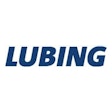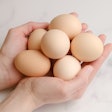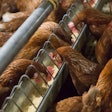
Hens housed in conventional cages are responsible for over 90 percent of egg production in the U.S., but the number of eggs produced by cage-free hens has been increasing at a rapid rate the last few years. The precise break out of caged and cage-free egg production is not available, but industry sources all agree that cage-free production is on the rise.
Moving over 5 percent market share
Sean Francey, product manager at VAL-CO, said that some of the cage-free and organic egg marketing cooperatives are experiencing annual sales growth of double digit percentages and sometimes as much as 20 percent growth in a single year. He said that there has been some speculation that if the national hen welfare legislation passes (H.R. 3798), that the labeling requirements, which dictate that eggs from cage housed hens are labeled as such, could lead to a couple of percent shift in sales of eggs from cage housed hens to cage-free. Given the relatively low current base for cage-free eggs, Francey estimated it to be around 5 percent of total egg production, this shift could have a big impact. Francey said, “I am not sure I agree that labeling will have a dramatic impact on egg sales, but we are looking at cage-free as something that is going to continue to grow.”
Terry Pollard, vice president of North American sales and marketing at Big Dutchman, estimates that overall cage-free egg production in the U.S. has doubled from around 3 percent of the total egg market to 6 percent in just the last couple of years. The growth in cage-free production doesn’t show any sign of letting up, according to Pollard. “Based on equipment sales that have not been installed yet, I think the cage-free market percentage this time next year will be in the area of 8 percent,” he said.
Lessons from the EU experience
The ban on conventional cages for housing hens in the EU, which went into affect on January 1, 2012, allows for the use of enriched cages at 116 square inches per bird in most countries. Germany adopted its own stricter standard which requires 124 square inches per bird for hens under 4.4 pounds and 139 square inches per bird for hens over 4.4 pounds.
Activist groups in the Netherlands and Germany have not been satisfied with enriched cages or larger enriched colonies for housing hens. These groups have successfully pushed retailers in these two countries to announce that they will only sell eggs from cage-free hens. The net result of retailer actions in certain countries, variations in standards between Germany and the rest of the EU, and different standards of living between Northern and Southern Europe have produced marked differences between countries in how birds are housed.
In a report prepared for the International Egg Commission, it was estimated that over 60 percent of hens in France are housed in enriched cages, while in the UK over half of all hens are raised free-range. In the Netherlands and Germany, cage-free barn systems house over 70 and 60 percent of the hens, respectively. Over half the hens in Denmark are housed in enriched cages, but another 20 percent are raised in organic systems.
“In general, enriched cages dominate the South of Europe up to France,” said Bernd Kuhlencord, managing director at Big Dutchman. “In Northern Europe, 50 percent or more of the hens are in alternative (non-cage) systems. The barn egg has replaced the cage egg as the low cost egg. Free-range eggs are higher priced and can be marketed slightly easier than barn eggs, since there is less supply at this moment. The ecological egg is a niche product for which everybody is expecting constant growth.”
Cage-free farm size
The normal size for cage-free operations in the EU is 15,000 to 40,000 layers per house, according to Kuhlencord. He said that some larger farms have as many as 400,000 birds. “I am only aware of one farm with 1 million hens in alternative systems in the EU,” Kuhlencord said.
Demand for cage-free eggs in the U.S. is increasing, but it is not concentrated in any one market. Because of this, many egg producers have moved into cage-free production on a relatively small scale, adding cage-free houses to their operations as needed while maintaining their existing business for eggs produced in cages. This manner of expansion of cage-free production capacity may be changing. Industry sources report that the first U.S. million bird cage-free egg farm is not far away.
Marketing opportunity
The growth in cage-free egg production that has been experienced so far has been driven by consumer and activist demand. Welfare legislation in states like California may become a big factor in the growth of cage-free production in the future. While cage-free eggs are more costly to produce than eggs from hens housed in conventional or enriched cages, Kuhlencord said it is important for producers to remember that their customers and the marketplace are what have been driving the increase in cage-free production.
If producers really pay attention to what consumers want, then cage-free production can offer an opportunity for increased profits. Based on the EU experience, Kuhlencord said, “Alternative systems can be an excellent opportunity for those egg producers who start with the right system at the right time, because they will have an advantage in production and marketing. We had to learn in Europe that the rules ‘imposed’ by the government only initiated the change, but the introduction was accelerated a lot by the supermarkets, who recognized that they could improve their image and their margins per square meter of sales surface at the same time, by adding higher-priced alternative eggs to their shelves.”

















